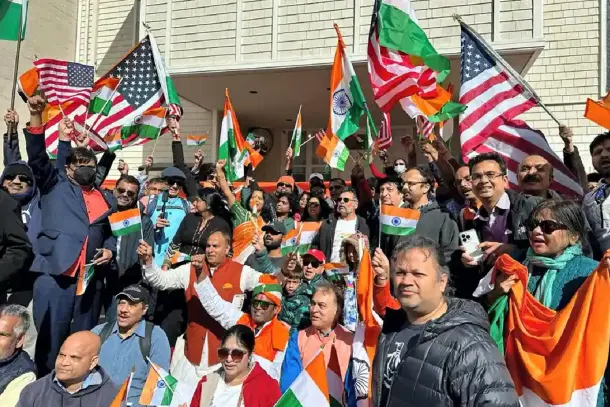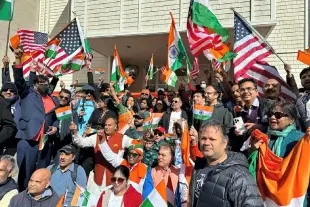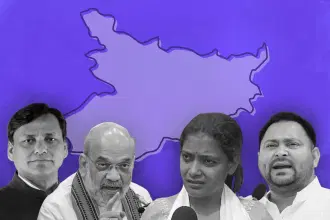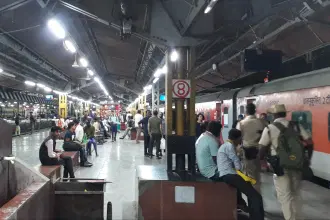Commentary
Why We Are Silent: The Indian-American Paradox
Jay Munshi
Oct 11, 2025, 09:00 AM | Updated Oct 10, 2025, 10:18 PM IST
Save & read from anywhere!
Bookmark stories for easy access on any device or the Swarajya app.


Here's something that doesn't add up: Indian-Americans are among the most educated and affluent communities in the United States. We are running companies, teaching at universities, performing surgeries, and writing code that powers half the internet. Yet, when Washington slaps massive tariffs on Indian goods or announces a six-figure H-1B filing fee, the response from our community is... silence.
It is not that we do not care. It is more complicated than that.
The H-1B Hangover
In the 1990s, it was a golden ticket for talented Indians to build lives in America. However, it also created something ugly. A system in which Indian IT firms made billions by essentially renting engineers at bargain rates. I have seen the salary slips. Skilled workers earn 30–40% below market rate while their employers repatriate massive profits back to India.
Here is what makes it worse: the H-1B minimum salary has been frozen at 60,000 dollars since 1998. When the programme launched in 1990, 60,000 dollars was 200% of median household income. To match that today in the coastal tech hubs where most H-1B workers actually live, the minimum would need to be between 270,000 and 330,000 dollars.
A “specialty occupation” worker now earns less than the average American household and can afford one-seventh of a median home instead of half. What was designed as a visa for elite, highly compensated talent has devolved into a programme for below-market labour with degrees.
True, most H-1B workers today earn above the 60,000 dollar floor. Median salaries in tech run much higher. However, here is the real damage from that outdated floor. It anchors the entire wage structure downward. Companies can hire skilled foreign workers at rates that undercut what American citizens would demand for the same work.
The Indian engineers who built Silicon Valley in the 1990s were paid like the premium talent they were. Now the system has turned into something else: a way to hire sound engineers cheaply, wrapped in the language of skills shortages.
It is worth asking whether India would offer comparable visas to underprivileged African students or those from less privileged countries. The silence on that hypothetical reveals how nations actually think about labour imports when they are not the beneficiaries.
Many of those early H-1B workers are now U.S. citizens. And when they see Washington cracking down on those same firms today, there is not a lot of sympathy. Some even think it is deserved. That is not patriotism talking; that is the bitter aftertaste of being treated like a “cash commodity” for years.
We Cannot Agree on Anything
Our community is deeply fractured on these issues. Current H-1B holders are terrified of losing their jobs and status. Naturalised citizens who went through the grind feel the system needs reform, even if it hurts the companies that brought them here. And the tech elite who have made it big are thinking globally, not particularly loyal to Indian outsourcing firms or American immigration policy.
This division paralyses us. We have enormous collective wealth but no unified lobby. No powerful PAC. No coordinated fundraising.
Other communities, such as Jewish Americans, Cuban Americans, and Korean Americans, have figured out how to translate economic success into political influence. We have not. We are dominant in Silicon Valley but practically invisible on Capitol Hill.
Our Kids Are Getting Squeezed
The second generation sees all of this. They grew up comfortable, attended good schools, and did everything their parents asked. Then they graduate and find themselves competing against H-1B workers who have more years of experience and lower salary expectations. The same programme their parents used to get ahead is now working against them.
The Dreamers Act gave undocumented youth a path to stability, in-state tuition, and public support. Meanwhile, children from legal H-1B families pay out-of-state tuition in states where their parents pay taxes. Children of H-1B parents lose dependent status at 21.
And what of the Indian government? Conspicuously quiet. It will fight over trade deals but will not advocate for its own citizens stuck in visa limbo. Where is the support from the Indian government for Indian citizens? We miss the late Mrs Sushma Swaraj a lot. She would have taken this up. Her hands-on, citizen-first diplomacy made a difference for people like us. That style of advocacy seems to have turned into matching confrontational tones.
The Tariff Mess
The trade fight with India did not start yesterday. Back in 2018, the U.S. imposed 25% tariffs on steel and 10% on aluminium. India lost its GSP trade privileges in 2019 and hit back with agricultural tariffs. Things cooled down for a while, but by 2025, reciprocal tariffs had reached 50%.
Both countries claim they are seeking fairness. Both are practising protectionism. And the diaspora is stuck in the middle, watching India demand respect and America demand loyalty, with neither side particularly interested in what we think.
The Dignity Problem
There is a deeper issue here about respect. India remembers being wary of Clinton's intervention during the 1999 Kargil conflict. Even though he sided with India, New Delhi bristled at any hint of third-party mediation on Kashmir.
Indians remember Trump’s premature ceasefire announcement in 2025 bitterly. Every time Washington tries to insert itself between India and Pakistan, New Delhi sees condescension, not concern. And most Indian-Americans agree with the Indian viewpoint.
Indian politicians need to protect their dignity. American politicians want credit for solving problems and influencing Indian-American votes. Both would probably react the same way if roles were reversed.
Money Without Influence
Here is the embarrassing part. Despite our wealth and professional success, we have built almost nothing in terms of political infrastructure. Donations are scattered and reactive. We do not have issue-based PACs. We do not have think tanks focused on our concerns. We do not have the organised advocacy that our economic power should command.
This is why H-1B reform and trade equity barely register in congressional hearings, despite affecting millions of us. We have positioned ourselves as America’s model minority—hardworking, high-achieving, grateful. But gratitude does not translate to influence, and modesty does not win policy debates.
What Needs to Change
The pragmatism that helped us survive and succeed is now limiting our impact. Both governments have learnt they can ignore us without consequence.
If we want equitable trade policies, humane visa reform, and fair opportunities for our children, we need to get serious about building power. Real PACs, funded advocacy organisations, coordinated lobbying efforts.
This is not about being loud for its own sake. It is about recognising that in a democracy, policy follows organised pressure. Other groups learnt this decades ago. It is about time we did.
The Bottom Line
The Indian-American story has always been about working hard, keeping your head down, and letting merit speak for itself. That strategy got us far. But at a certain point, restraint becomes invisibility.
We have earned the right to shape policies that affect our lives, our children's futures, and the countries we care about. We also see the parallels between Atmanirbhar Bharat and MAGA.
The question is not whether we have something valuable to say. It is whether we are finally ready to say it—loudly, collectively, and without apology.





